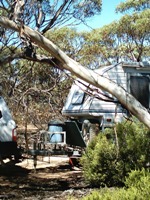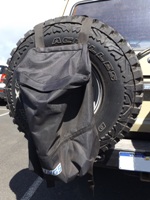Australia So Much to See


With more and more people touring
The CMCA (Campervan and Motorhome Club of
If you don’t have a built in sullage tank and water needs to be removed completely from the area rather than tipped into the bush at the perimeter of the camp site, a bucket with a sealable lid or a plastic jerry can will suffice. Collapsible twenty litre camping water canisters can be purchased cheaply from camping stores or the camping section of discount stores. They take up next to no room when packed away, and can be filled with waste water to take it away. In case of spillage (should the lid come lose), carry in bathroom if you have one or on tray of ute if you have one. Otherwise you can sit it in your large ‘wash bowl’ which should contain any accidental spillage. Some Self Contained Only campgrounds do not permit collection by buckets or unsealed canisters so you must have a built in waste water tank or an approved portable tank to stay in these. Dispose of thoughtfully when the opportunity arises.
Be aware of the environment when bush or rest area camping and use minimal and environmentally friendly detergents and soaps. Never dispose of waste water near a water course. In most areas, water disposal is not a problem and in many National Park campgrounds there is no provision for disposal of waste water and the parks have not suffered from campers disposing of their water on or near to their camp sites. Some caravan parks ask that you let the water go onto the grass, and this may well be the only water the lawns will get. Move your hose around to different places and water the patches most in need.
We use the simple solution of a bucket to collect the sink and shower waste water more often than getting out the waste water hose. Occcasionally when using the sullage hose, a little of the sink water my come back in through the shower drain. This does not occur when letting the water drain into a bucket. If this does happen, a simple cure is to fit plug to the shower drain. We have only one outlet whereas some modern caravans have two which prevents this flow back or have a one way valve fitted.
Any food scraps that may wash down the sink can be strained out by tying a stocking over the outlet if using a bucket.
Camp grounds littered with soiled streamers of toilet paper in so many outback areas show disgraceful and thoughless behaviour
of some campers and visitors. In low rainfall areas the paper can remain for years. For those who don’t have a portable
toilet, by taking a spade (bearing in mind some areas of
If you are travelling remote and need to empty a toilet cassette, similarly bearing in mind
proximity to water course and distance from where travellers may park or camp, dig a hole and bury what should be just a liquid slurry. Rather than do this near a rest area, stop somewhere else along the road and walk into the bush or desert sands to dispose of the
contents. It is unlikely that anyone will ever go that spot, and the buried slurry is inoffensive anyway.
On long
hikes in sensitive areas you may be required to carry out your faeces. Suitable products are outlined in this article.
Another
simple and lightweight alternative toilet for occasional use, or when hiking, can be purchased from Ezygonow. This solution
enables Leave No Trace toileting at all times, and saves the need for digging or squatting.
If you have to dispose of cooking fat eg from a roast or from boiling up corned beef, dig a small hole in a spot well away from where
most people will walk, and fill it with natural leaves. Pour out the semi cooled liquid onto the leaves which will strain out
the fat as it sets onto the cool leaves. Cover with topsoil. The fat will degrade harmlessly along with the leaves. Avoid getting fat into your sullage tank, hose or bucket.
Many National Parks and free camp grounds do not have a rubbish collection service. If you take it in, take it out. Simple really. If bins are provided, use them correctly, using recycling stations if available. If the bins are full, take your rubbish with you. Scavengers such as dingoes and crows are skilled rubbish bin hunters and will tear apart any bags of rubbish not placed in a secure bin. Provided it is safe to have a fire and it is permitted in the campground, you can dispose of paper and cardboard packaging by burning it in your camp fireplace. Ensure rubbish is fully burnt before leaving and as with any fire, make sure it is completely extinguished and the ground leveled (leaving no trace). Never bury non degradable rubbish.


